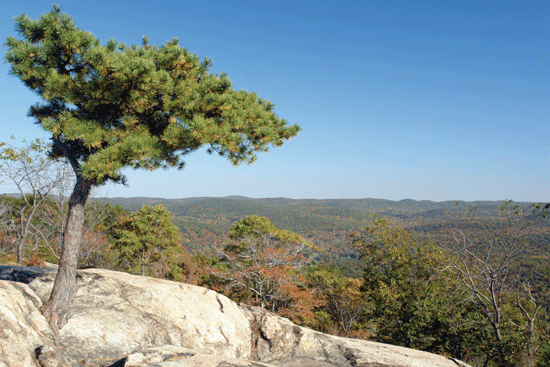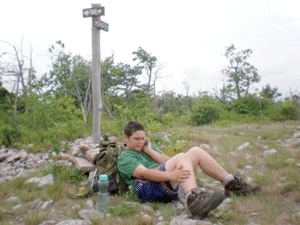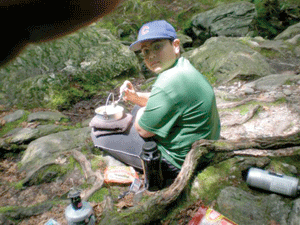
The Appalachian Trail might just be the best kept family vacation secret
in America. For families serious about their child’s education, few
other opportunities give a more well-rounded training than hiking a
section on the trail.
On the trail it is not uncommon to see bears, deer, snakes, frogs, and
chipmunks. What is conspicuously absent, however, are young hikers who
are going more than a few miles or a few hours.
Resting on a bench in front of an historic church in Harper’s Ferry,
“Grasshopper” had earned the right to sit down. On a clear and bright
July Sunday morning, this twelve-year-old Chicago native, who is also
known as Jeremy Wood by his friends back home, was wrapping up a
500-mile trek with Phil Wood, his father. During the past 40 days we had
hiked through seven states on the Appalachian Trail, slept in cabins,
tents, mice-infested shelters, church basements, a jail, homes of
strangers, homes of friends, a train station, hostels, cheap hotels, and
a monastery. Our diet consisted of ramen noodles, peanut butter tacos,
canned wieners, and about everything we could find when we came off the
trail. While on the trail we met a retired New York City fireman, two
Israeli officers, European men wearing kilts, retired executives, a
professor, a lawyer, a doctor, school teachers, college students, and
two women from Belgium.

|
|
Jeremy, resting by a trail marker
|
Education on the Trail
On our last night on the Trail, we camped at a shelter less than a mile
north of the Gathland National War Correspondents Memorial in Maryland.
In the trail register a home educator hiking with another parent and
their children wrote, “This is the best homeschool outing we have
taken.”
Many academic and life skills are reviewed as miles and elevations are
tallied to determine daily destinations, unfamiliar plants and animals
are discovered, history is unfolded as you walk the soil where it
happened, and books are read and journals written as each day draws to a
close under skies that seem unaffected by the typical big-city lights
and pollution. Whether it is in honing skills needed for reading a map
or in determining true north with a compass, every part of a young
person is challenged on the trail.
History of the Trail
The Appalachian Trail is a 2,175-mile, 18-inch-wide trail extending 14
states between Georgia and Maine. Hikers have enjoyed the trail for
about 80 years and almost 10,000 individuals are recorded as completing
it. While most thru-hikers take about six months, the record time is
just over 40 days.
For Purdue engineering student, “Peanut,” and his Hoosier pharmacist
dad, the trail will take seven years. “We began when I was in eighth
grade, hiking a section each year, and we should finish next summer.”
With “Peanut” in college and schedules conflicting, father and son have
resorted to hiking portions of the trail separately, but they are
determined to meet next year in New Hampshire and finish together. “We
started in Georgia together, and we want to finish in Maine together.”

|
|
A beautiful road shack for the tired traveler
|
No experience is necessary to hike the trail. For us Woods, except for
an occasional backyard sleepout, most of our outdoor experience has
included a stay at a hotel. Our trip began after a trucker friend from
Chicago dropped us off at a bus station, just a few hours away from our
Lee, Massachusetts, starting point. Though it was raining when we
entered the trail, at 891 miles away from home, there was no turning
back.
What You Need
to Begin Hiking
The key to hiking the trail is to keep everything lightweight. Extremely
lightweight equipment tends to also be extremely expensive, but adequate
gear can be found on sporting goods clearance racks or at department
stores. A good, well-fitting backpack is a must. While most hikers use
models with internal frames, the bulkier external frame backpacks are
cooler and generally less expensive. Also needed is a small tent or
hammock, since shelters are not always available and are occasionally
full. Two aluminum walking sticks are recommended and one can sometimes
double as the tent post at night. Equipment is needed for cooking,
including utensils and pans, though many hikers use denatured alcohol or
bottles of “Heet” that they burn in a makeshift tuna can as a stove.
Also plan to take water bottles, some system for water treatment (such
as iodine tablets for purification), several pairs of smart-wool socks,
nylon sock liners, a sturdy pair of hiking shoes (we both traded in our
boots after hiking northern Pennsylvania), a small first-aid kit, and
some type of dry victuals, such as Ramen noodles or oatmeal. A typical
hiker menu will include Pop-tarts for breakfast; a snack of nuts, jerky,
or trail-mix for lunch; and meals such as macaroni and cheese for
dinner.

|
|
Resting on the rocks
|
Many businesses are located along the trail for supplies and a
thru-hiker’s guide is available on the Internet or at the Appalachian
Trail headquarters in Harper’s Ferry. In addition to the guide,
topographical maps not only show the trail ahead, but also identify
nearby roads and towns in the case of an emergency. In most states, cell
phone reception is regularly available.
Do not even consider cotton clothing, jeans, or any attire that is
highly absorbent and dries slowly. Underarmor, or spandex-type
materials, dry quickly and wick the water away from the skin.
Finally, while dogs are wonderful companions and are often seen on the
trail, it is best to leave Fido at home.
How Far Should You
Plan to Hike?
To get a real feel for the trail, to gain respect from the hard-core
thru hikers, and to achieve some semblance of “trail legs,” you probably
need to plan at least a four to six-week hike. Anything less will be
extremely exhausting and less enjoyable.
For us, during the first few days, hiking five or six miles of difficult
terrain wore us out. By the end of our journey, hiking in the high teens
or even over 20 miles a day was not unusual.
Most thru hikers will do upwards of 20 miles each day, taking a “zero,”
or a day of rest on occasion.
We took a sabbatical zero every Sunday, finding a local church for
worship, and getting an inexpensive hotel for the night. It was a way to
not only honor God, but to take a shower and sleep in a real bed. Every
Monday after lunch we were back on the trail. We also rested on July
4th, taking in a country fair and sleeping the night at a free hostel at
a Presbyterian Church. One Sunday we took an early morning train into
New York City from the train station just across the river from West
Point Academy. After attending church in Manhattan, we ate lunch in the
Bronx, and then spent the night with a Salvadoran family in Long Island.
Taking the time to care for our blisters, we were able to take a bus
back to the trail, refreshed and healed. Even off the trail, many
lessons were learned. Some of the best aspects of the trail included the
churches we visited, the people that gave us rides into town, and the
folks we met along the way.
With childhood obesity on the rise, gas prices inflated, and quality
time together as a family at a premium, a respite on the trail may be
exactly what the homeschooled family needs to complete their living
curriculum.
Jeremy Wood is an 8th grade home school student from the Chicago
suburbs. He spent the beginning of his 12th year hiking the Appalachian
Trail to raise money for homeless children. Phil, his father, is honored
to also be his pastor.










